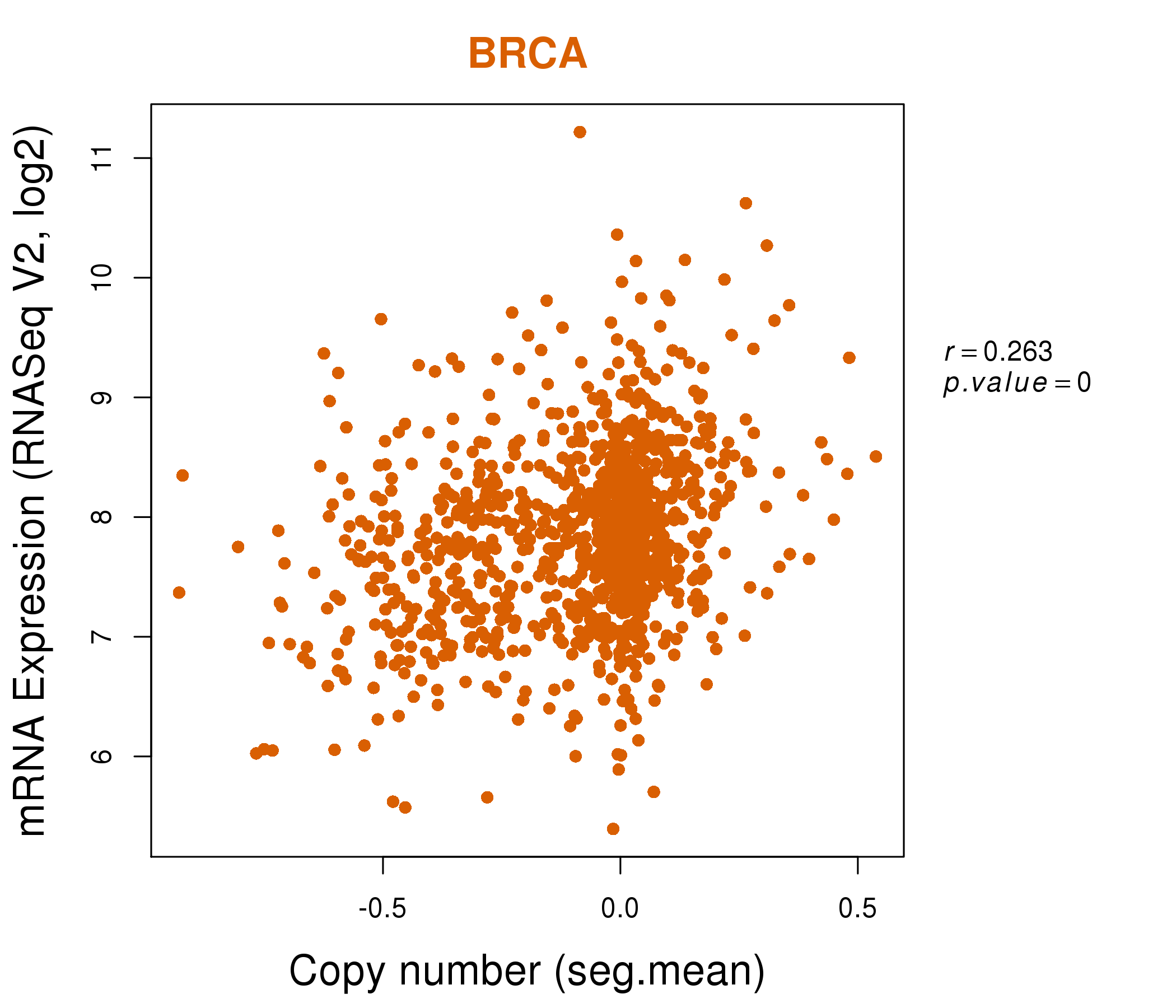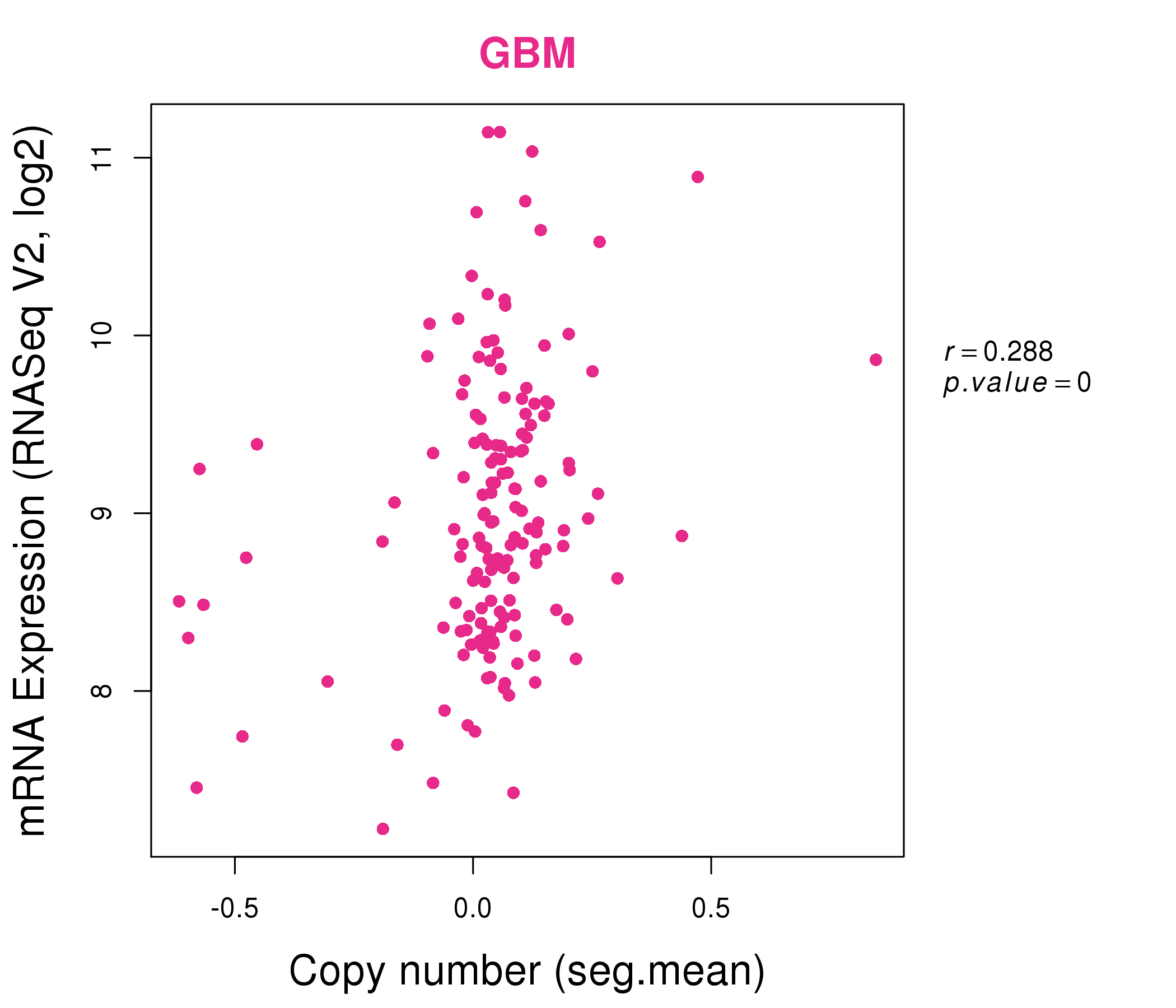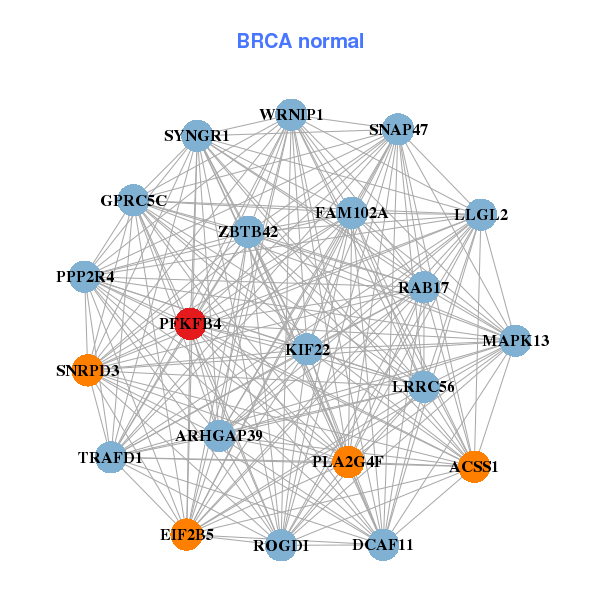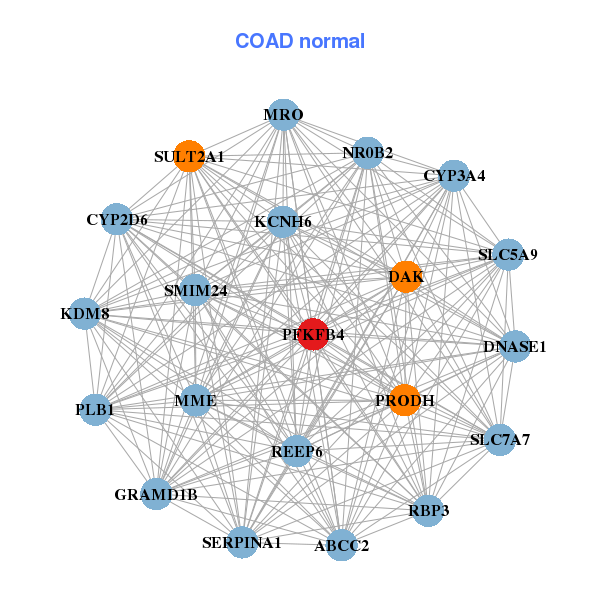|
||||||||||||||||||||
| |
| Phenotypic Information (metabolism pathway, cancer, disease, phenome) |
| |
| |
| Gene-Gene Network Information: Co-Expression Network, Interacting Genes & KEGG |
| |
|
| Gene Summary for PFKFB4 |
| Basic gene info. | Gene symbol | PFKFB4 |
| Gene name | 6-phosphofructo-2-kinase/fructose-2,6-biphosphatase 4 | |
| Synonyms | - | |
| Cytomap | UCSC genome browser: 3p22-p21 | |
| Genomic location | chr3 :48555116-48594227 | |
| Type of gene | protein-coding | |
| RefGenes | NM_004567.2, | |
| Ensembl id | ENSG00000114268 | |
| Description | 6-phosphofructo-2-kinase/fructose-2,6-biphosphatase-46-phosphofructo-2-kinase/fructose-2,6-bisphosphatase 46PF-2-K/Fru-2,6-P2ase 46PF-2-K/Fru-2,6-P2ase testis-type isozymePFK/FBPase 4bifunctional enzyme with kinase and biphosphatase activities | |
| Modification date | 20141207 | |
| dbXrefs | MIM : 605320 | |
| HGNC : HGNC | ||
| Ensembl : ENSG00000114268 | ||
| HPRD : 05613 | ||
| Vega : OTTHUMG00000133528 | ||
| Protein | UniProt: go to UniProt's Cross Reference DB Table | |
| Expression | CleanEX: HS_PFKFB4 | |
| BioGPS: 5210 | ||
| Gene Expression Atlas: ENSG00000114268 | ||
| The Human Protein Atlas: ENSG00000114268 | ||
| Pathway | NCI Pathway Interaction Database: PFKFB4 | |
| KEGG: PFKFB4 | ||
| REACTOME: PFKFB4 | ||
| ConsensusPathDB | ||
| Pathway Commons: PFKFB4 | ||
| Metabolism | MetaCyc: PFKFB4 | |
| HUMANCyc: PFKFB4 | ||
| Regulation | Ensembl's Regulation: ENSG00000114268 | |
| miRBase: chr3 :48,555,116-48,594,227 | ||
| TargetScan: NM_004567 | ||
| cisRED: ENSG00000114268 | ||
| Context | iHOP: PFKFB4 | |
| cancer metabolism search in PubMed: PFKFB4 | ||
| UCL Cancer Institute: PFKFB4 | ||
| Assigned class in ccmGDB | C | |
| Top |
| Phenotypic Information for PFKFB4(metabolism pathway, cancer, disease, phenome) |
| Cancer | CGAP: PFKFB4 |
| Familial Cancer Database: PFKFB4 | |
| * This gene is included in those cancer gene databases. |
|
|
|
|
|
|
| ||||||||||||||
Oncogene 1 | Significant driver gene in | |||||||||||||||||||
| cf) number; DB name 1 Oncogene; http://nar.oxfordjournals.org/content/35/suppl_1/D721.long, 2 Tumor Suppressor gene; https://bioinfo.uth.edu/TSGene/, 3 Cancer Gene Census; http://www.nature.com/nrc/journal/v4/n3/abs/nrc1299.html, 4 CancerGenes; http://nar.oxfordjournals.org/content/35/suppl_1/D721.long, 5 Network of Cancer Gene; http://ncg.kcl.ac.uk/index.php, 1Therapeutic Vulnerabilities in Cancer; http://cbio.mskcc.org/cancergenomics/statius/ |
| KEGG_FRUCTOSE_AND_MANNOSE_METABOLISM REACTOME_METABOLISM_OF_CARBOHYDRATES REACTOME_GLUCOSE_METABOLISM | |
| OMIM | |
| Orphanet | |
| Disease | KEGG Disease: PFKFB4 |
| MedGen: PFKFB4 (Human Medical Genetics with Condition) | |
| ClinVar: PFKFB4 | |
| Phenotype | MGI: PFKFB4 (International Mouse Phenotyping Consortium) |
| PhenomicDB: PFKFB4 | |
| Mutations for PFKFB4 |
| * Under tables are showing count per each tissue to give us broad intuition about tissue specific mutation patterns.You can go to the detailed page for each mutation database's web site. |
| - Statistics for Tissue and Mutation type | Top |
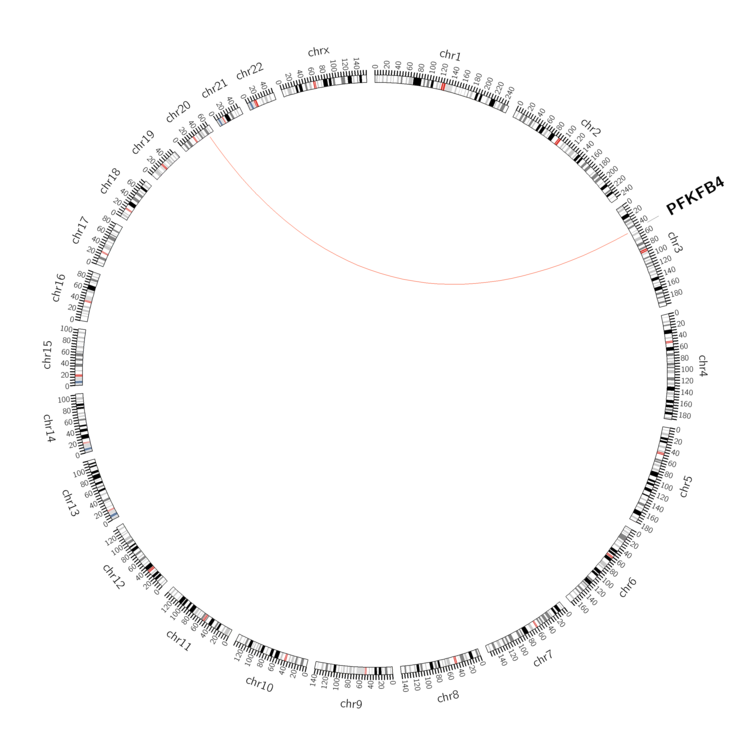 |
| - For Inter-chromosomal Variations |
| * Inter-chromosomal variantions includes 'interchromosomal amplicon to amplicon', 'interchromosomal amplicon to non-amplified dna', 'interchromosomal insertion', 'Interchromosomal unknown type'. |
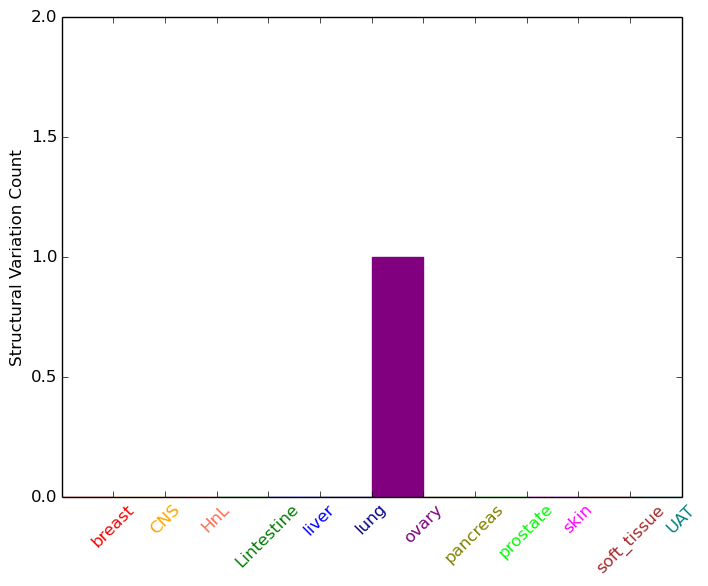 |
| - For Intra-chromosomal Variations |
| There's no intra-chromosomal structural variation. |
| Sample | Symbol_a | Chr_a | Start_a | End_a | Symbol_b | Chr_b | Start_b | End_b |
| ovary | PFKFB4 | chr3 | 48566459 | 48566479 | chr20 | 52127856 | 52127876 |
| cf) Tissue number; Tissue name (1;Breast, 2;Central_nervous_system, 3;Haematopoietic_and_lymphoid_tissue, 4;Large_intestine, 5;Liver, 6;Lung, 7;Ovary, 8;Pancreas, 9;Prostate, 10;Skin, 11;Soft_tissue, 12;Upper_aerodigestive_tract) |
| * From mRNA Sanger sequences, Chitars2.0 arranged chimeric transcripts. This table shows PFKFB4 related fusion information. |
| ID | Head Gene | Tail Gene | Accession | Gene_a | qStart_a | qEnd_a | Chromosome_a | tStart_a | tEnd_a | Gene_a | qStart_a | qEnd_a | Chromosome_a | tStart_a | tEnd_a |
| CV325109 | SPATA13 | 16 | 243 | 13 | 24808042 | 24808266 | PFKFB4 | 236 | 386 | 3 | 48583324 | 48583474 | |
| Top |
| There's no copy number variation information in COSMIC data for this gene. |
| Top |
|
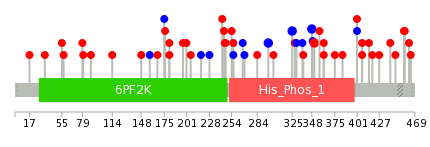 |
| Top |
| Stat. for Non-Synonymous SNVs (# total SNVs=33) | (# total SNVs=9) |
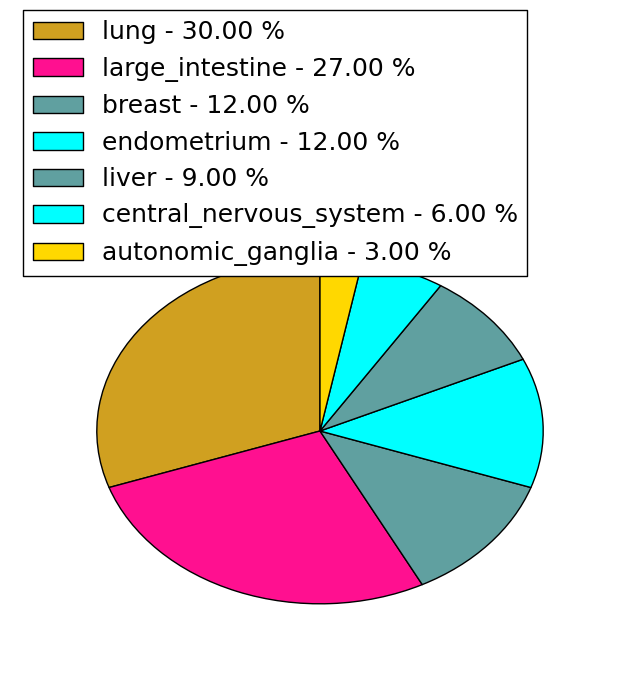 | 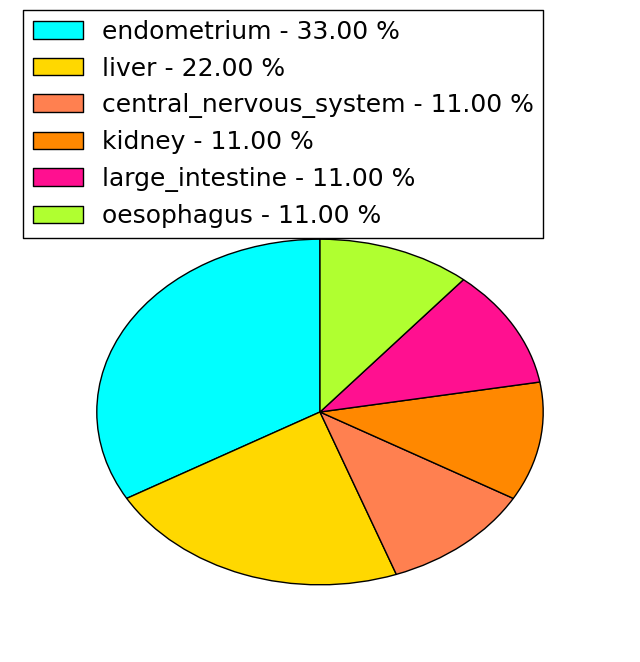 |
(# total SNVs=1) | (# total SNVs=0) |
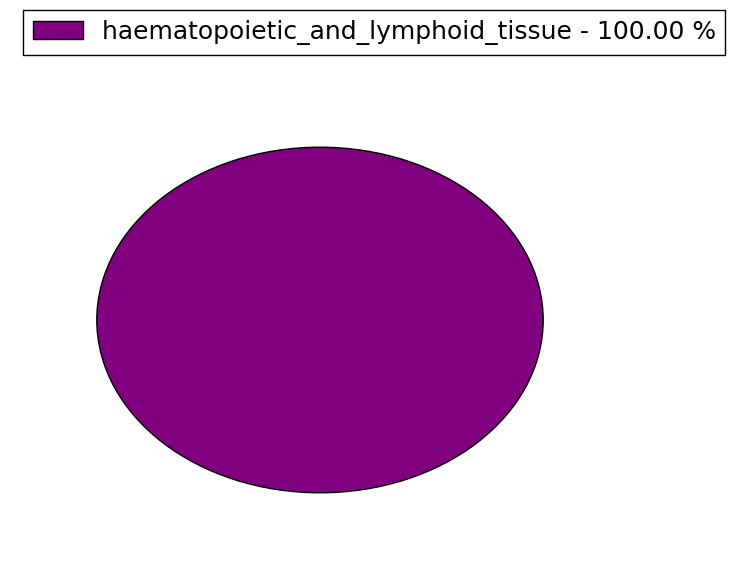 |
| Top |
| * When you move the cursor on each content, you can see more deailed mutation information on the Tooltip. Those are primary_site,primary_histology,mutation(aa),pubmedID. |
| GRCh37 position | Mutation(aa) | Unique sampleID count |
| chr3:48573041-48573041 | p.L297L | 2 |
| chr3:48563038-48563038 | p.R351Q | 2 |
| chr3:48563046-48563046 | p.F348F | 2 |
| chr3:48573763-48573763 | p.R256W | 2 |
| chr3:48561136-48561136 | p.A407V | 2 |
| chr3:48572957-48572957 | p.N325N | 2 |
| chr3:48557223-48557223 | p.R456K | 1 |
| chr3:48573802-48573802 | p.M243L | 1 |
| chr3:48563004-48563004 | p.K362N | 1 |
| chr3:48576698-48576698 | p.A167P | 1 |
| Top |
|
 |
| Point Mutation/ Tissue ID | 1 | 2 | 3 | 4 | 5 | 6 | 7 | 8 | 9 | 10 | 11 | 12 | 13 | 14 | 15 | 16 | 17 | 18 | 19 | 20 |
| # sample | 1 | 1 | 5 | 1 | 2 | 1 | 7 | 1 | 9 | 3 | 6 | |||||||||
| # mutation | 1 | 1 | 5 | 1 | 2 | 1 | 7 | 1 | 9 | 3 | 7 | |||||||||
| nonsynonymous SNV | 1 | 4 | 1 | 1 | 6 | 1 | 5 | 2 | 4 | |||||||||||
| synonymous SNV | 1 | 1 | 1 | 1 | 1 | 4 | 1 | 3 |
| cf) Tissue ID; Tissue type (1; BLCA[Bladder Urothelial Carcinoma], 2; BRCA[Breast invasive carcinoma], 3; CESC[Cervical squamous cell carcinoma and endocervical adenocarcinoma], 4; COAD[Colon adenocarcinoma], 5; GBM[Glioblastoma multiforme], 6; Glioma Low Grade, 7; HNSC[Head and Neck squamous cell carcinoma], 8; KICH[Kidney Chromophobe], 9; KIRC[Kidney renal clear cell carcinoma], 10; KIRP[Kidney renal papillary cell carcinoma], 11; LAML[Acute Myeloid Leukemia], 12; LUAD[Lung adenocarcinoma], 13; LUSC[Lung squamous cell carcinoma], 14; OV[Ovarian serous cystadenocarcinoma ], 15; PAAD[Pancreatic adenocarcinoma], 16; PRAD[Prostate adenocarcinoma], 17; SKCM[Skin Cutaneous Melanoma], 18:STAD[Stomach adenocarcinoma], 19:THCA[Thyroid carcinoma], 20:UCEC[Uterine Corpus Endometrial Carcinoma]) |
| Top |
| * We represented just top 10 SNVs. When you move the cursor on each content, you can see more deailed mutation information on the Tooltip. Those are primary_site, primary_histology, mutation(aa), pubmedID. |
| Genomic Position | Mutation(aa) | Unique sampleID count |
| chr3:48573763 | p.F348F | 2 |
| chr3:48563046 | p.R256R | 2 |
| chr3:48561136 | p.P375S | 1 |
| chr3:48587662 | p.S201F | 1 |
| chr3:48563100 | p.K362N | 1 |
| chr3:48576698 | p.C197F | 1 |
| chr3:48561153 | p.K362E | 1 |
| chr3:48572951 | p.S176R | 1 |
| chr3:48576723 | p.R351Q | 1 |
| chr3:48561204 | p.A167A | 1 |
| * Copy number data were extracted from TCGA using R package TCGA-Assembler. The URLs of all public data files on TCGA DCC data server were gathered on Jan-05-2015. Function ProcessCNAData in TCGA-Assembler package was used to obtain gene-level copy number value which is calculated as the average copy number of the genomic region of a gene. |
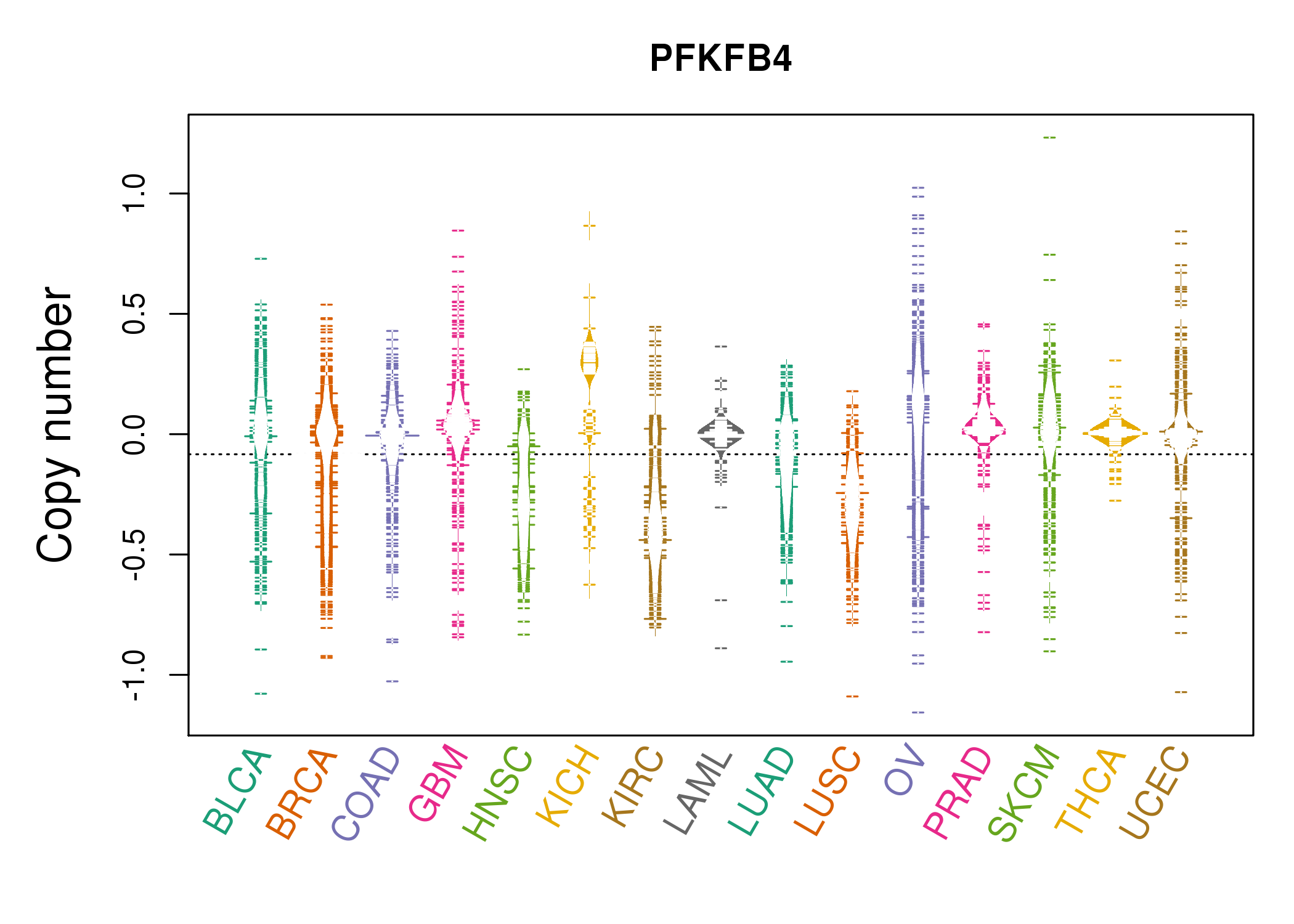 |
| cf) Tissue ID[Tissue type]: BLCA[Bladder Urothelial Carcinoma], BRCA[Breast invasive carcinoma], CESC[Cervical squamous cell carcinoma and endocervical adenocarcinoma], COAD[Colon adenocarcinoma], GBM[Glioblastoma multiforme], Glioma Low Grade, HNSC[Head and Neck squamous cell carcinoma], KICH[Kidney Chromophobe], KIRC[Kidney renal clear cell carcinoma], KIRP[Kidney renal papillary cell carcinoma], LAML[Acute Myeloid Leukemia], LUAD[Lung adenocarcinoma], LUSC[Lung squamous cell carcinoma], OV[Ovarian serous cystadenocarcinoma ], PAAD[Pancreatic adenocarcinoma], PRAD[Prostate adenocarcinoma], SKCM[Skin Cutaneous Melanoma], STAD[Stomach adenocarcinoma], THCA[Thyroid carcinoma], UCEC[Uterine Corpus Endometrial Carcinoma] |
| Top |
| Gene Expression for PFKFB4 |
| * CCLE gene expression data were extracted from CCLE_Expression_Entrez_2012-10-18.res: Gene-centric RMA-normalized mRNA expression data. |
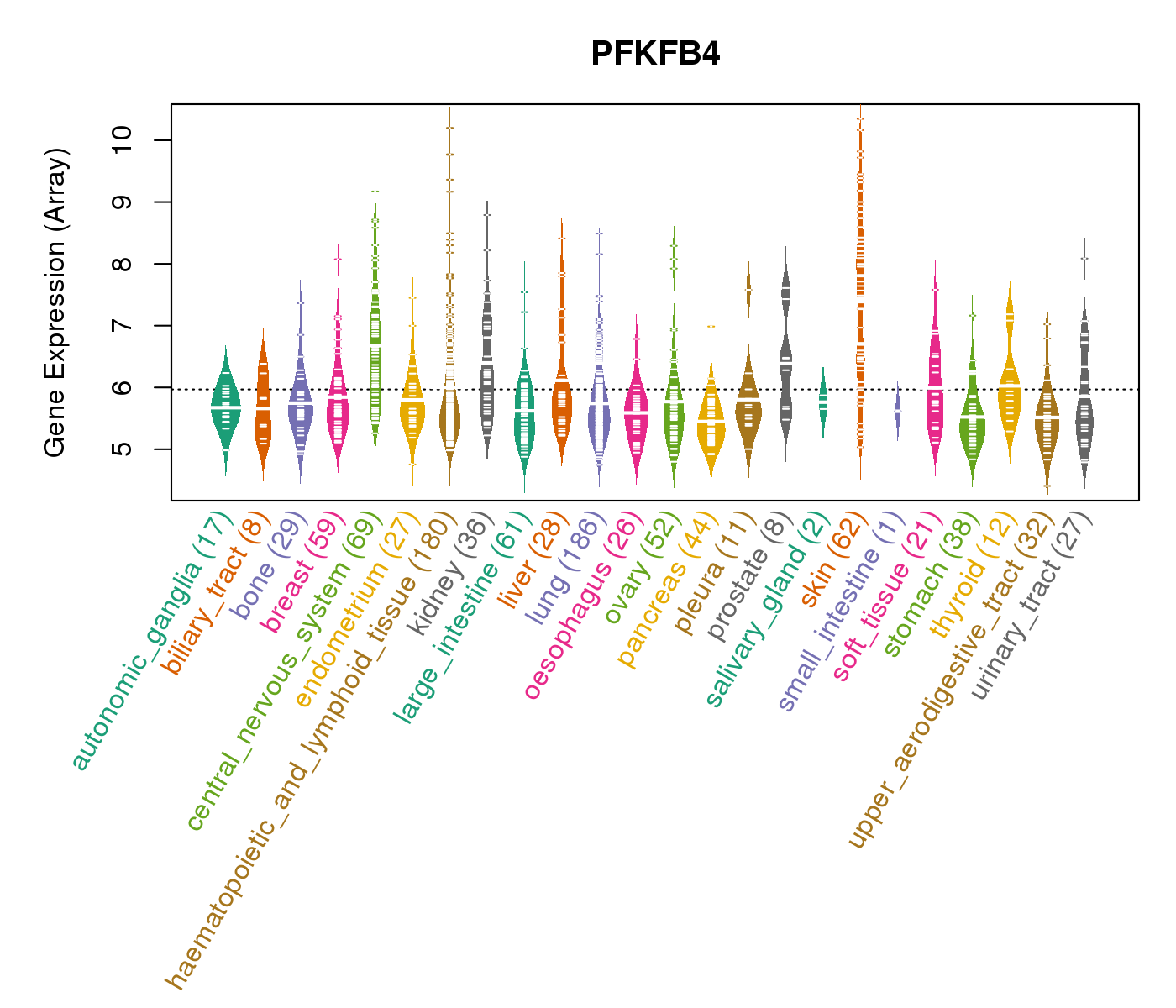 |
| * Normalized gene expression data of RNASeqV2 was extracted from TCGA using R package TCGA-Assembler. The URLs of all public data files on TCGA DCC data server were gathered at Jan-05-2015. Only eight cancer types have enough normal control samples for differential expression analysis. (t test, adjusted p<0.05 (using Benjamini-Hochberg FDR)) |
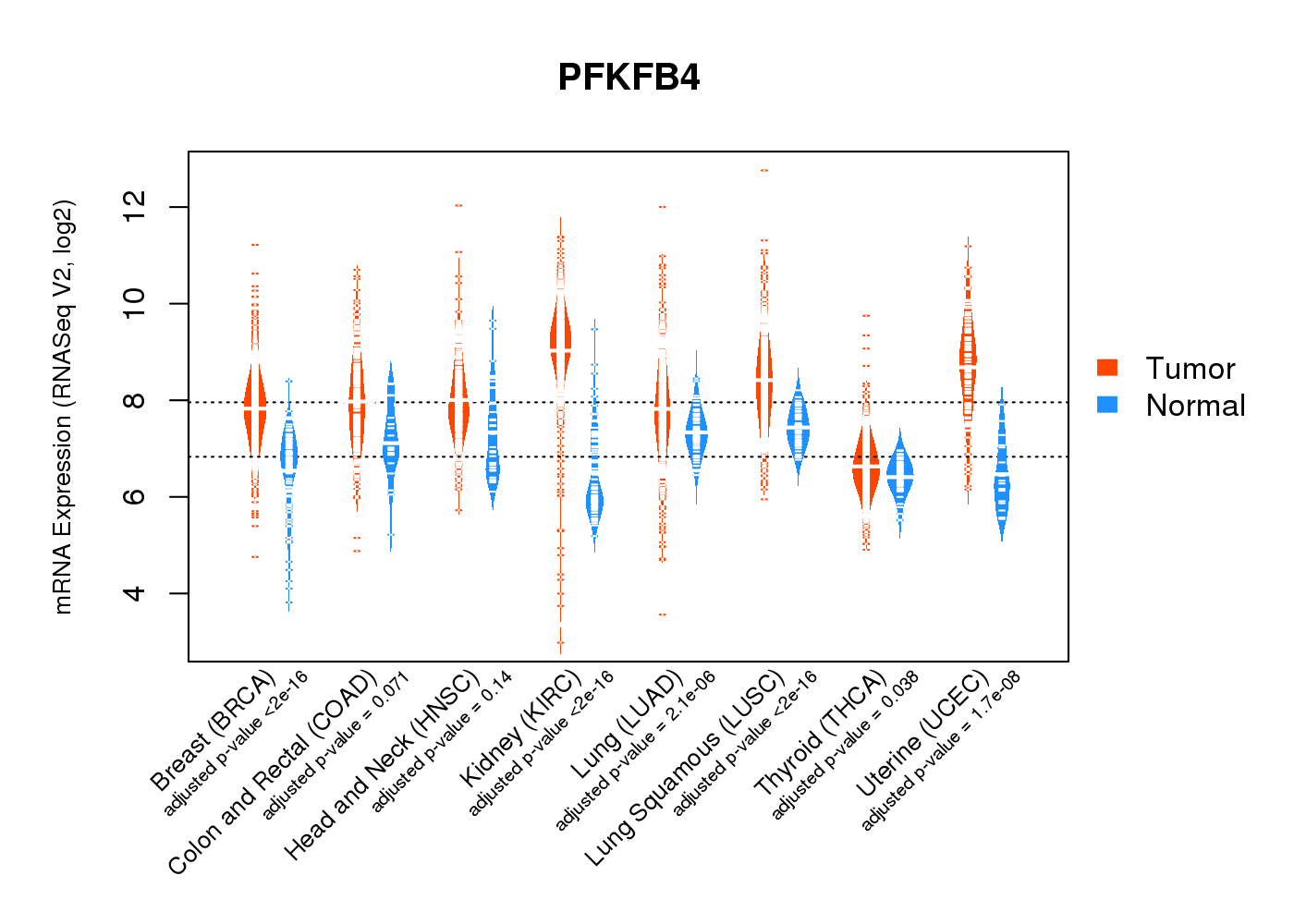 |
| Top |
| * This plots show the correlation between CNV and gene expression. |
: Open all plots for all cancer types
 |
|
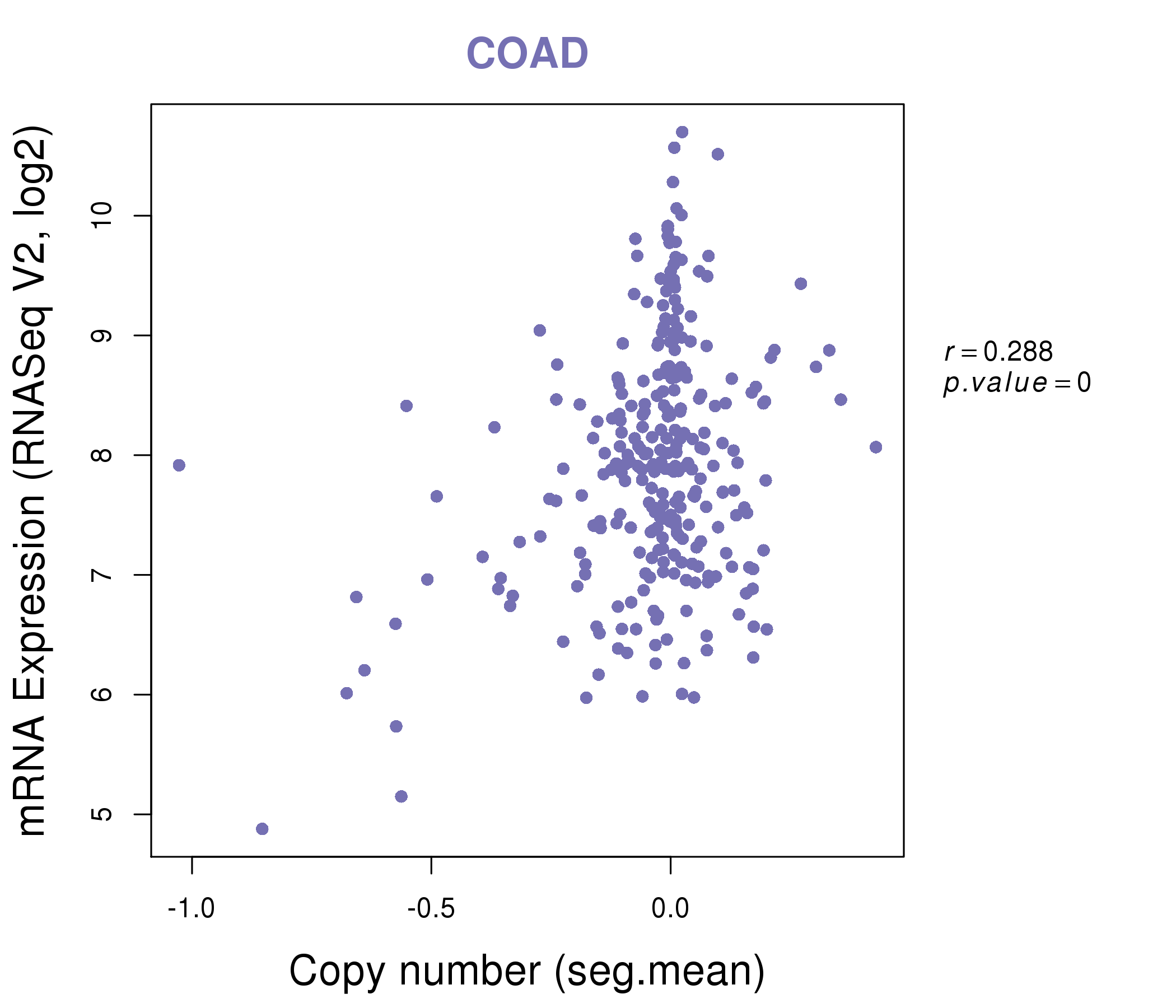 |
|
| Top |
| Gene-Gene Network Information |
| * Co-Expression network figures were drawn using R package igraph. Only the top 20 genes with the highest correlations were shown. Red circle: input gene, orange circle: cell metabolism gene, sky circle: other gene |
: Open all plots for all cancer types
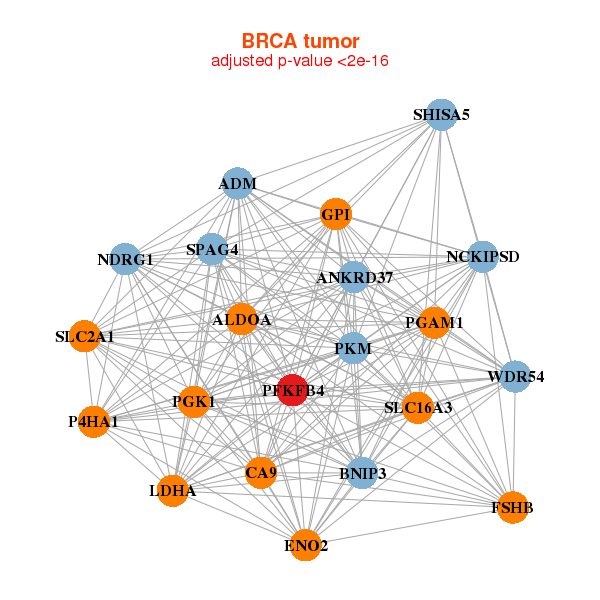 |
| ||||
| ADM,ALDOA,ANKRD37,BNIP3,CA9,ENO2,FSHB, GPI,LDHA,NCKIPSD,NDRG1,P4HA1,PFKFB4,PGAM1, PGK1,PKM,SHISA5,SLC16A3,SLC2A1,SPAG4,WDR54 | ACSS1,ARHGAP39,DCAF11,EIF2B5,FAM102A,GPRC5C,KIF22, LLGL2,LRRC56,MAPK13,PFKFB4,PLA2G4F,PPP2R4,RAB17, ROGDI,SNAP47,SNRPD3,SYNGR1,TRAFD1,WRNIP1,ZBTB42 | ||||
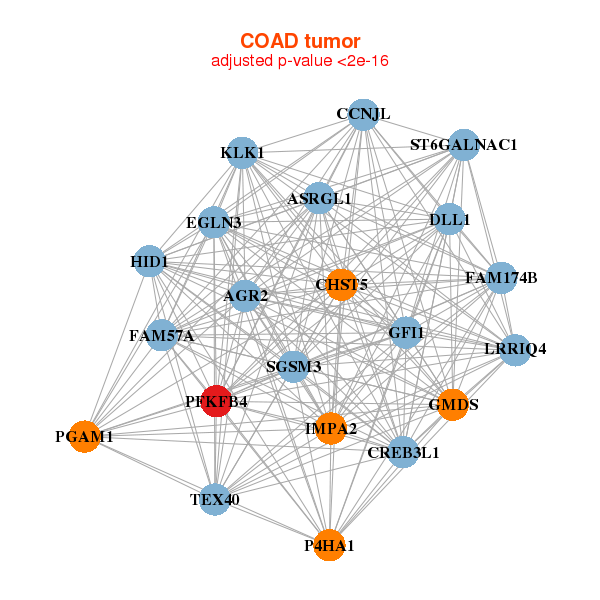 |
| ||||
| AGR2,ASRGL1,TEX40,HID1,CCNJL,CHST5,CREB3L1, DLL1,EGLN3,FAM174B,FAM57A,GFI1,GMDS,IMPA2, KLK1,LRRIQ4,P4HA1,PFKFB4,PGAM1,SGSM3,ST6GALNAC1 | ABCC2,SMIM24,CYP2D6,CYP3A4,DAK,DNASE1,GRAMD1B, KDM8,KCNH6,MME,MRO,NR0B2,PFKFB4,PLB1, PRODH,RBP3,REEP6,SERPINA1,SLC5A9,SLC7A7,SULT2A1 |
| * Co-Expression network figures were drawn using R package igraph. Only the top 20 genes with the highest correlations were shown. Red circle: input gene, orange circle: cell metabolism gene, sky circle: other gene |
: Open all plots for all cancer types
| Top |
: Open all interacting genes' information including KEGG pathway for all interacting genes from DAVID
| Top |
| Pharmacological Information for PFKFB4 |
| DB Category | DB Name | DB's ID and Url link |
| * Gene Centered Interaction Network. |
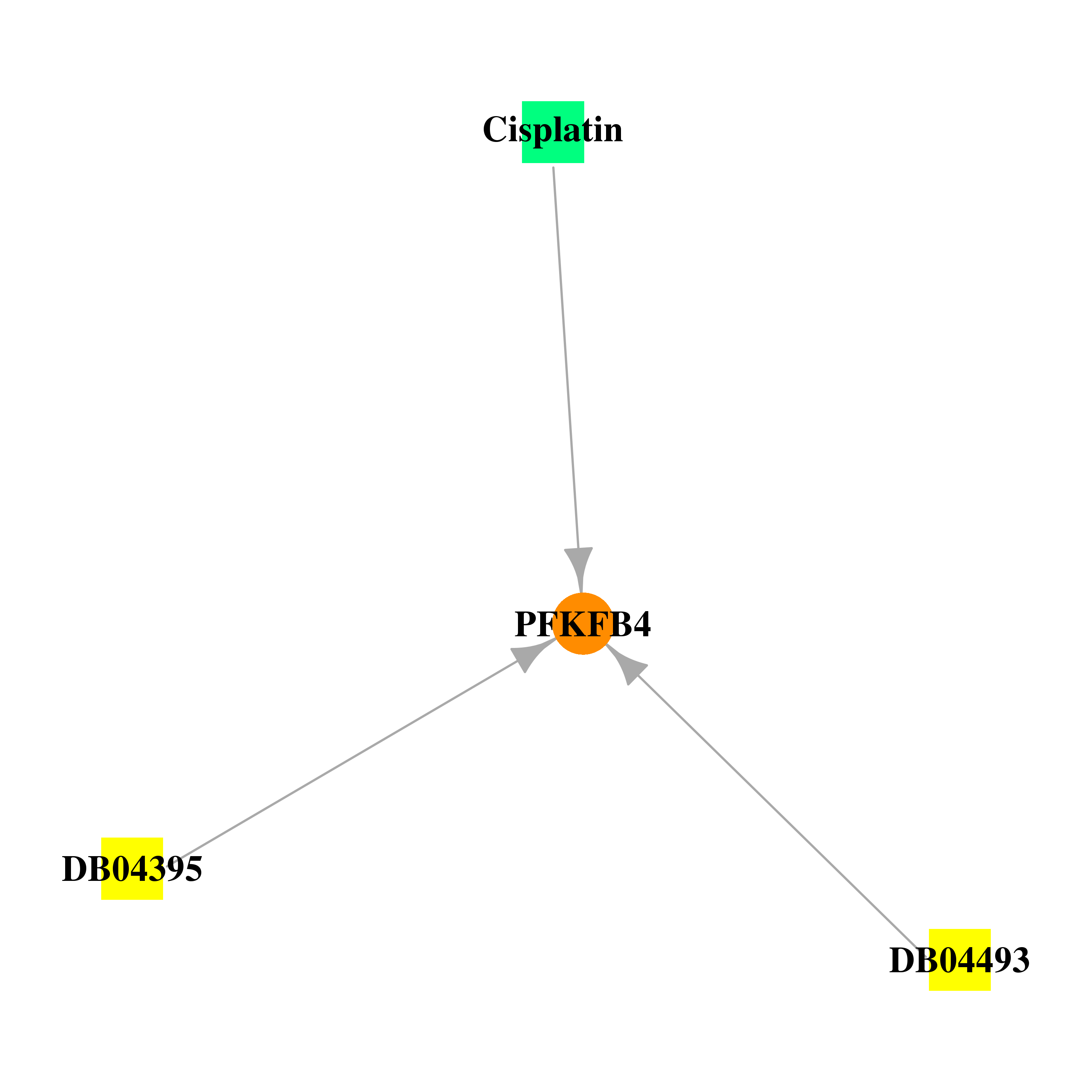 |
| * Drug Centered Interaction Network. |
| DrugBank ID | Target Name | Drug Groups | Generic Name | Drug Centered Network | Drug Structure |
| DB04395 | 6-phosphofructo-2-kinase/fructose-2,6-biphosphatase 4 | experimental | Phosphoaminophosphonic Acid-Adenylate Ester | 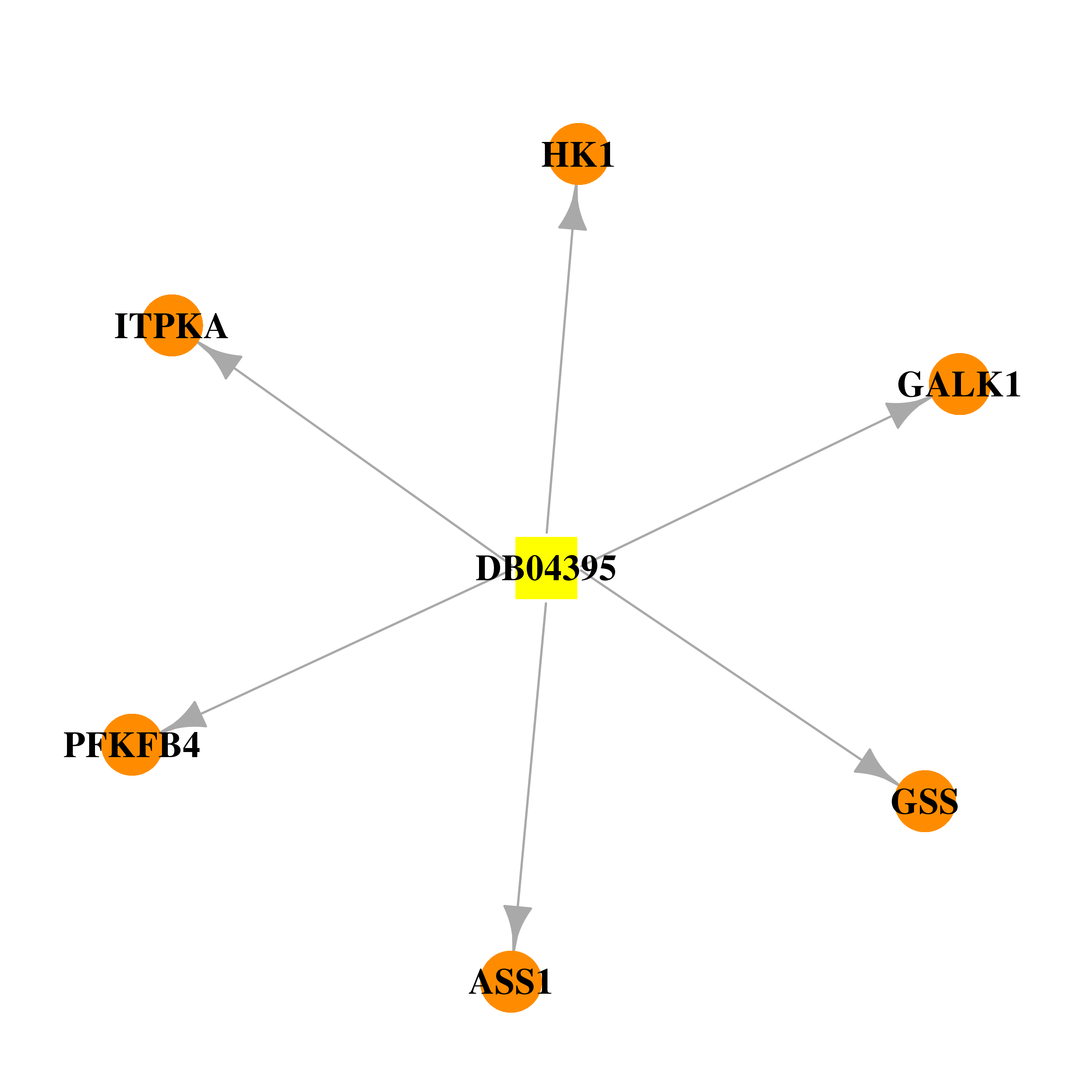 | 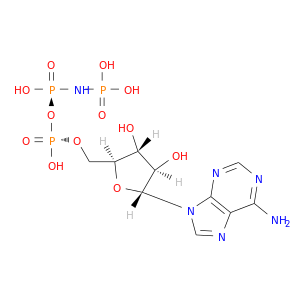 |
| DB04493 | 6-phosphofructo-2-kinase/fructose-2,6-biphosphatase 4 | experimental | Fructose-6-Phosphate | 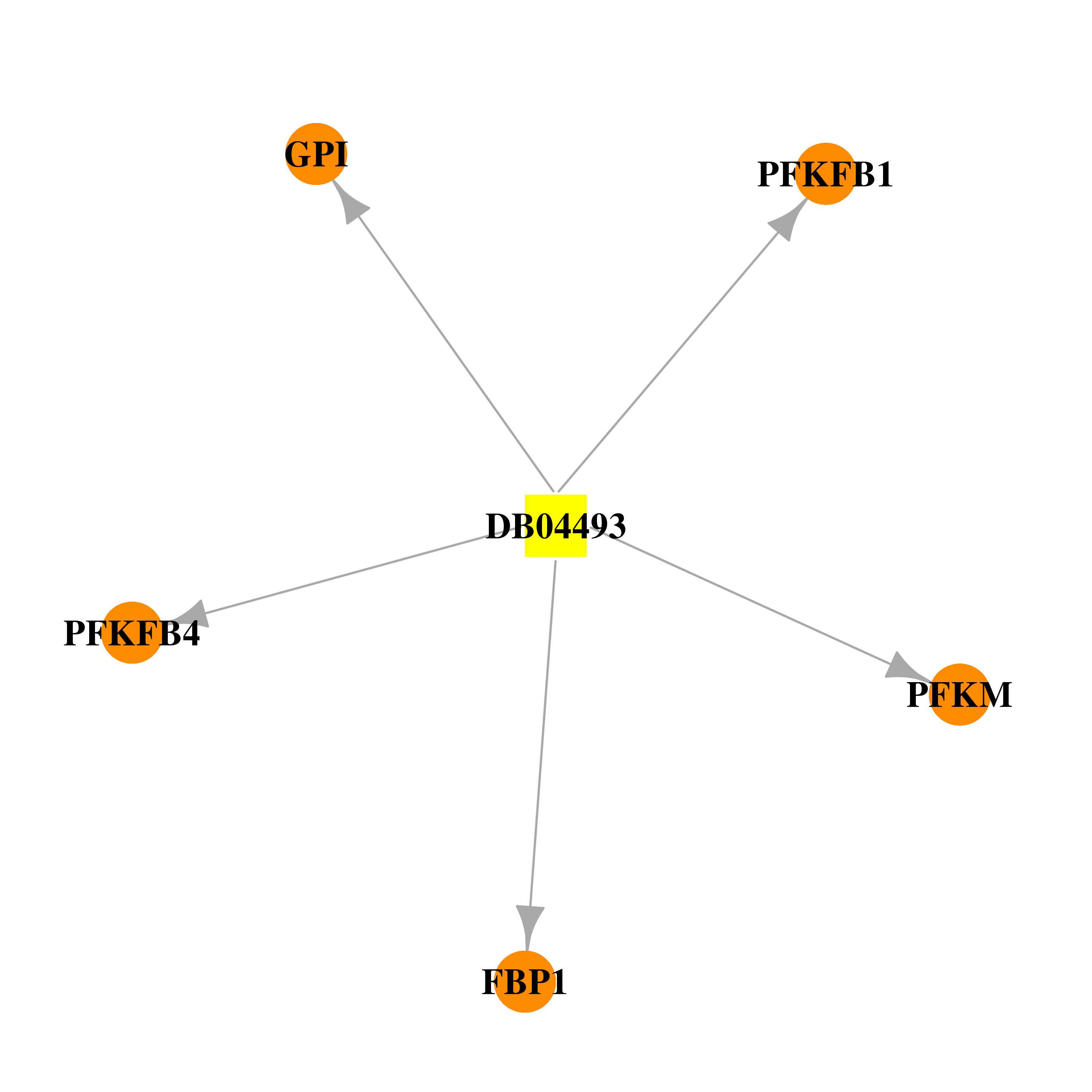 | 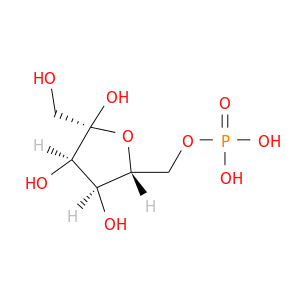 |
| DB00515 | 6-phosphofructo-2-kinase/fructose-2,6-biphosphatase 4 | approved | Cisplatin |  | 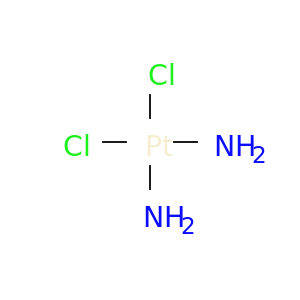 |
| Top |
| Cross referenced IDs for PFKFB4 |
| * We obtained these cross-references from Uniprot database. It covers 150 different DBs, 18 categories. http://www.uniprot.org/help/cross_references_section |
: Open all cross reference information
|
Copyright © 2016-Present - The Univsersity of Texas Health Science Center at Houston @ |






